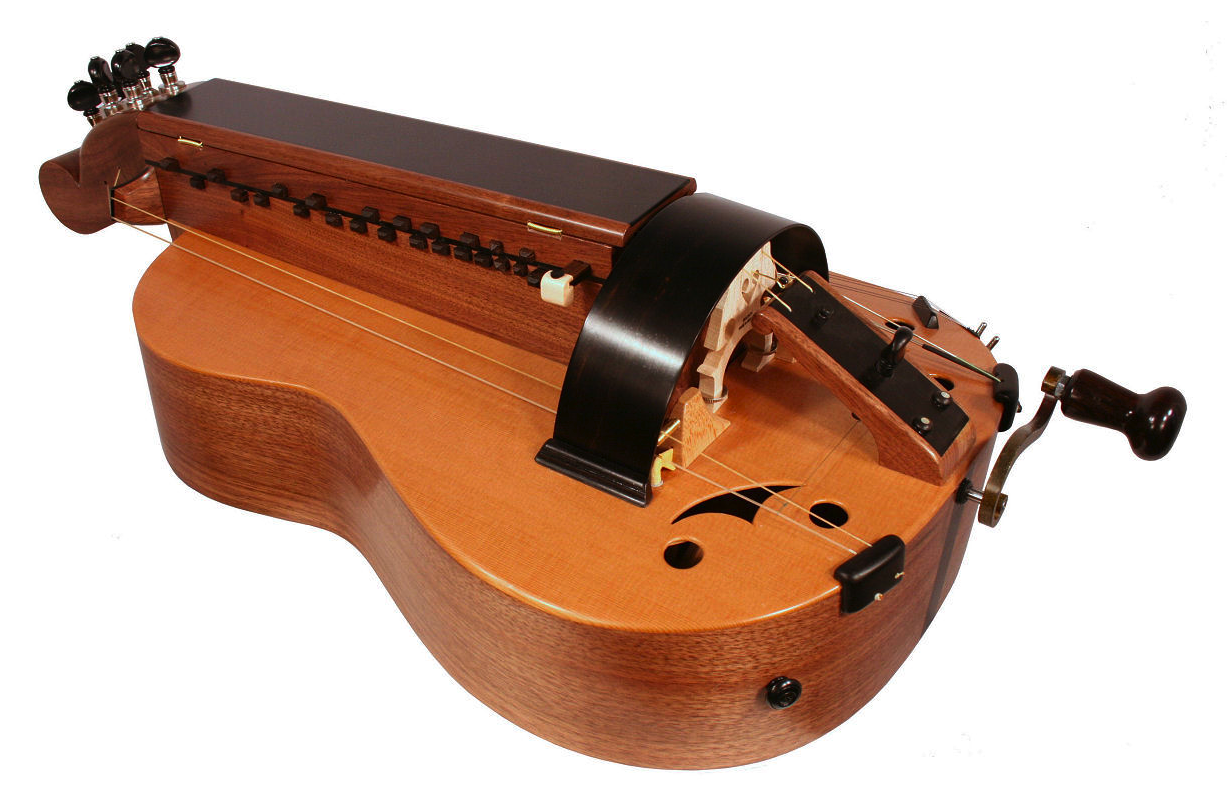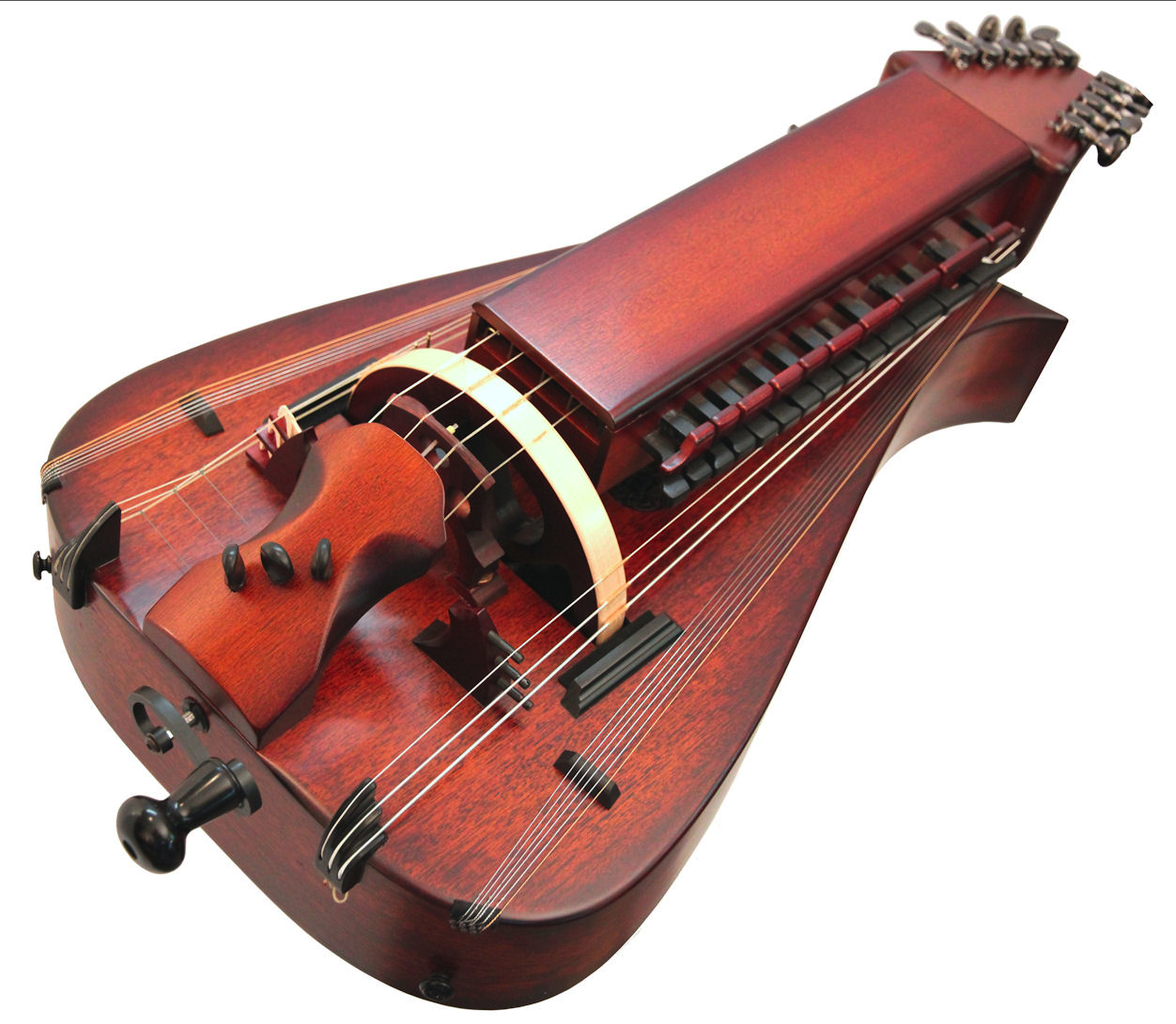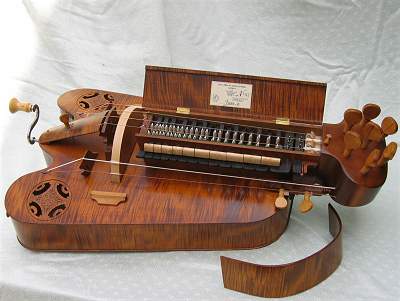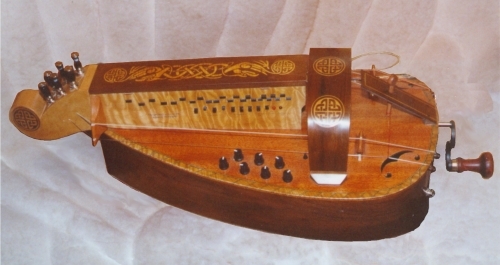Hurdy gurdy
The hurdy-gurdy (also: hurdy-gurdy ) is a stringed instrument in which the strings are swept by a built wheel that is rotated by a crank. The vibrating length of one or more melody strings is mechanically shortened via buttons to change the pitch.
Most sound one or more drone strings with at a constant pitch. The hurdy-gurdy is therefore counted as the bagpipe to the Borduninstrumenten. To generate rhythmic snare sounds often serves a snare web.
The data obtained in museums Bohemian instruments have no drone, the traditional instruments from Galicia no Schnarr web.
The hurdy-gurdy is used among other things in the traditional music, early music, jazz, Industrial, in rock music and in contemporary music.
Mechanism of the reduction of the melody strings
Each key is located on a slide rod having a rectangular cross-section. The push rods are inserted through corresponding holes across two parallel boards ( called tangent box ). These boards are mounted on the instrument that the melody strings run parallel between them and thus the push rods perpendicular to the melody strings.
At the push rods a component is fixed for each melody string, which functionally corresponds to a " covenant." When you press a button, the corresponding " frets " are pressed against the melody strings and thereby at the same time shortens the vibrating length of all strings. The " frets " hurdy-gurdy are also referred to as tangents because they " affect " the strings (touching), or as "flagged " because of its traditional form.
Falling back of the key into the initial position is performed by gravity. The " frets " are the exact votes usually movable.
Occasionally found on this basic model different mechanisms in which about falling back the keys is achieved by spring force, also there is a mechanism in which the " frets " are mounted on rotating discs.
Designs
Through the times and regions you will find a wide variety of designs. A general standardization can not be ascertained, but some types can be narrow.
Alto - hurdy-gurdy
This modern instrument has been developed since the eighties, according to the ideas of sound the instrument maker and the needs of hurdy gurdy players that use the hurdy-gurdy in a modern musical context. The special attention is given to the expansion of the tonal diversity and dynamics of the volume. Famous musicians who have especially contributed to the development of these instruments are Clastrier Valentin, Gilles Chabenat, Germán Díaz, Matthias Loibner and Simon Wascher.
The name is derived from the extended range of these instruments, of " Alto " (French for Viola). These instruments usually have a deeper sound, a total of more tonal range of the keyboard, up to three octaves, more strings - up to 27 - using the different strings then up to four and a half octaves and built Preamp.
Important instrument makers for the development of this type are Denis Siorat, Robert Mandel, Philippe Mousnier and Wolfgang Weichselbaumer.
Designs from France
For the hurdy-gurdy, French Vielle à Roue (literally wheel fiddle), today there is a strong tradition in France, particularly in the Centre region. His form with a body made chips, similar to the lute, received this instrument of courtly instrument makers at the beginning of the 18th century. As known by name instrument makers of this period, who built this fine sounding instruments are Henri Bâton from Versailles, originating from Normandy brothers Pierre Louvet (1709-1784) and Jean Louvet (1718-1793) and Jean -Nicolas Lambert (1708-1759 ) and Nicolas Colson (* 1785 in Mirecourt ) to call. Besides tools with chip corpus also instruments were built with gitarrenförmigem corpus.
In the 19th century, the instrument adapted more and more to use in the village music and became more robust. The instruments of this period, approximately from Pimpard or Pajot from Jenzat in Auvergne same, the built today. For Brittany, the instrument makers built from the Centre hurdy-gurdy with a larger waisted sides corpus.
Designs from Hungary
The hurdy-gurdy, in Hungarian in the peasant language " nyenyere " called usually " tekerőlant " since the 20th century as or shortly " tekerő " ( tekerő = turning / cranking lant = lute), has a large waisted sides corpus and the particularity that melody, Schnarr and drone strings within the tangent box that houses the keyboard, run. This instrument has a snare system is adjusted unlike the French instruments with a wedge.
A characteristic of the Hungarian hurdy-gurdy is in relation to the French instruments smaller wheel and the smaller crank. This favors the use of the rattle (Hungarian recsegő ) the generation of short accented snare sounds, remember the sound character of a marching drum or tambourine.
Regionally, the Hungarian hurdy-gurdy in the Hungarian folk music of the areas around Szentes and Csongrád and in the area of the Danube south of Budapest is located. The first written references to hurdy-gurdy in Hungary can be found in the XVI. Century, the oldest Hungarian pictures of the instrument date from the time of Kuruzenkriege end of the 17th century. As part of the " Renaissance of the hurdy-gurdy ", which began in Hungary in the last third of the 20th century, Hungarian instrument producers have learned and taken over the construction of surviving folk musicians, so that Hungary, like France, a continuous tradition of the hurdy-gurdy construction and, game having. Frequently in folk music hurdy-gurdy players are handed a duet with clarinet, the clarinet the melody part and the lyre took over the function of an accompanying instrument. Historic illustrations of hurdy-gurdy from southern and eastern Austria have structural similarities to the Hungarian instruments.
" Bohemian " type
In a Czech museum instruments are repeatedly obtained, which do not have drone strings and therefore no snare string. Other features include: sympathetic strings, which are guided by the tangent box, cylindrical webs for each melody strings, concomitantly, each for one melody string plus sympathetic strings, a separate tailpiece, a special arrangement of the tangents / frets, which allows unlike other hurdy-gurdy with a keyboard tap off two melody strings in changing two sounds, as well as usually a lever to unmount a melody string.
Designs from Poland and Ukraine
These instruments from Eastern Europe, Poland, Ukraine, Belarus and Russia have a violin -shaped body, usually a very small wheel, and occasionally a special keyboard buttons.
Gothic hurdy-gurdy
This term refers to a variety of instrument used forms of current instrument makers are offered. Usually is understood as instruments whose body shape is formed until about 1650 from the beginning of the modern era after historical figures from the period. There are very accurate replicas for individual historical figures, such as after the instrument is shown in the picture The Garden of Earthly Delights by Hieronymus Bosch, but also purely speculative creations for use at medieval markets.
Organised Lira, Vielle Organisée or organ lyre
The organ -gurdy is actually a stand-alone instrument that consists of a hurdy-gurdy combined with a small organ. Due to the hurdy-gurdy keyboard also the mechanics of the organ valves is controlled and operated from the crank the winch system. In the eighteenth century were written for, among other compositions by Joseph Haydn and Ignaz Pleyel.
Organistrum
The oldest documented form is the Organistrum. The earliest known representations date from the 12th century ( Broecker, 1977, page 43). The Organistrum is an instrument for two players, one shortens the strings and the other operates the crank. It is known only from pictures and sculptures, our knowledge of the mechanism of shortening strings, mood, and other construction details based on circumstantial evidence. The Organistrum was used in church music.
Lyre (Latin Sinfonia )
This form is already in use from medieval representations. The instrument has the shape of an elongated box, a keyboard, and in front of the crank. The keyboard of the lyre may have been Doric in the original. The earliest pictures date from the 13th century ( Broecker, 1977, Figure 35). As with all of today's imitations Organistrum based on the text and images and derived conclusions. It has survived not historical instrument.
Repertoire
At all times, their existence was and is the hurdy-gurdy also an instrument of popular music, traditional dance music and song accompaniment in Europe. She also finds use in a wide variety of musical genres such as early music, jazz, Industrial, in rock music, in new music or on so-called medieval markets.
For the instrument has many works were written to be whether its circumference and its composition, the so-called " serious music " attributed to:
A large number of these works originated in the 18th century. In addition to works from the environment of the French court with composers such as Charles Bâton, Joseph Bodin de Bois Mortier, Charles Buterne, Nicolas and Esprit Philippe Chédeville, Michel Corrette, Evaristo Felice Dall'Abaco, Jean -François Boüin, Jean -Baptiste Dupuits, Jean and Jacques -Martin Hotteterre, Jean -Baptiste Lully, Jacques -Christophe Naudot, Jean -Philippe Rameau also composed Other individual works for the instrument: Leopold Mozart ( Sinfonia peasant Wedding ), Wolfgang Amadeus Mozart ( German dance, K. 602/3 ), Wenzel Müller ( opera The Sisters of Prague ), Joseph of Eybler ( German dance), Ferdinand Kauer ( Variazioni a Piu Istromenti [sic ], German dance ), Georg Druschetzky ( Parthia ), Paul Wranitzky ( German dance), Süssmayr ( Landler ), Gaetano Donizetti ( opera Linda di Chamonix ) and Carl Christian Agthe ( Symphony The Cuckoo ).
A number of works were also written for the organ lyre, see there.
Even contemporary composers write compositions of " serious music " for the instrument, including Edward Sielicki (1987: Pulchrum est quod est commensuratum ), Zygmunt Krauze ( 1974: Idyll, 1975: Fête galante et pastorale), R. Murray Schafer (2009: opera The Children 's Crusade ), Valentin Clastrier, Matthias Loibner, Germán Díaz, Stevie Wishart.
History
As Organistrum the hurdy-gurdy in texts from the tenth century is occupied. The earliest known representations date from the twelfth century. A significant change found the hurdy-gurdy from France in the eighteenth century. It formed during a not too long period of time many chamber works for " rural " instruments, including the hurdy-gurdy. The instrument is adapted for use in court ( chamber ) music and develop designs with loud like chips and body with organ stops. Many technical basics of instruments used today date back to this time.
Until the 19th century, the hurdy-gurdy in many European countries is documented. Today it is widespread in central France, north-western Spain and Hungary as a traditional musical instrument, in many parts of Europe it is experiencing a renaissance. The instrument has now probably more widespread than at any other time.
The names of the hurdy-gurdy
The modern names hurdy gurdy and more rarely, usually in the scientific texts, hurdy-gurdy are derived from Greek λύρα, Lyra, Old High German and Italian lira. The prefix rotation (of turn ) or cycling refers to the rotated by the player Streichrad.
In the historical sources, there are several other names: found only in medieval texts symphony itself ( Broecker, 1977, page 229). As Lyra mendicorum they recorded Athanasius Kircher in his Musurgia Universalis ( Iconismus VIII fol. 487). In historical sources, hurdy-gurdy is usually shortened to the lyre or hurdy-gurdy ( Broecker, 1977, pp. 229-233 ). The shape Lira happens about in terms of votes for the hurdy-gurdy in musical works ( New Mozart Edition online, KV 602/3, Trio). A distinction between the ancient plucked lyre, the Southeast European string instrument lyre and the actual hurdy gurdy is only possible from the context (Grimm online: lyre, 1a and 1b). The same applies to the term hurdy-gurdy. The reason is that after the rotation device of the hurdy-gurdy different devices with a similar crank were called lyre (Grimm online: lyre, 4), including small portable mechanical musical works that are operated with a lyre: a box with lyre, so hurdy-gurdy. Even names like Bawren lyres (Bauer lyre ) ( Praetorius, 1620, Table XXII) and begging lyre were used, not least to make a distinction between the ancient " lyre " and turning " lyre ". Savoyard organ called the hurdy-gurdy as an instrument of Savoyards, traveling and begging musicians from Savoy, who also played hurdy-gurdy ( Broecker, 1977, pp. 415-420 ). Therefore it is called in this context also beggars lyre.










